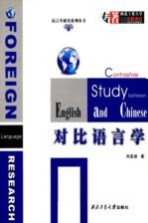图书介绍
对比语言学PDF|Epub|txt|kindle电子书版本网盘下载

- 刘美岩著 著
- 出版社: 西安:西北工业大学出版社
- ISBN:9787561227480
- 出版时间:2010
- 标注页数:192页
- 文件大小:47MB
- 文件页数:207页
- 主题词:对比语言学
PDF下载
下载说明
对比语言学PDF格式电子书版下载
下载的文件为RAR压缩包。需要使用解压软件进行解压得到PDF格式图书。建议使用BT下载工具Free Download Manager进行下载,简称FDM(免费,没有广告,支持多平台)。本站资源全部打包为BT种子。所以需要使用专业的BT下载软件进行下载。如BitComet qBittorrent uTorrent等BT下载工具。迅雷目前由于本站不是热门资源。不推荐使用!后期资源热门了。安装了迅雷也可以迅雷进行下载!
(文件页数 要大于 标注页数,上中下等多册电子书除外)
注意:本站所有压缩包均有解压码: 点击下载压缩包解压工具
图书目录
Chapter One Contrastive Analysis1
1.1 What Is Contrastive Analysis1
1.2 Background of Contrastive Analysis1
1.3 Rationale for Contrastive Analysis3
1.4 Theoretical Assumptions of Contrastive Analysis3
1.5 Theoretical Basis of Contrastive Linguistics4
1.5.1 Psychological Basis of Contrastive Analysis4
1.5.2 Linguistic Basis of Contrastive Analysis7
1.6 Application of TG Grammar to Contrastive Analysis10
1.7 Pedagogical Applications of Contrastive Analysis11
1.8 Criticisms of Contrastive Analysis11
Chapter Two Error Analysis13
2.1 What Is Error Analysis13
2.2 Rationale for Error Analysis13
2.3 Theoretical Assumptions of Error Analysis14
2.4 Claims of Error Analysis as a Primary Pedagogical Tool14
2.5 Describing Errors15
2.5.1 Error VS.Mistake15
2.5.2 Levels of Errors15
2.5.3 Types and Causes of Errors20
2.6 Techniques for Systematic Error Analysis23
2.6.1 Introduction23
2.6.2 Procedures23
2.7 Computerized Corpora of Errors29
2.8 Pedagogical Applications of Error Analysis29
2.9 Modern Contrastive Linguistics and Its Significance31
Chapter Three Contrastive Study between Chinese and English in Phonology33
3.1 What Is Phonology33
3.2 Phonological Analysis33
3.3 Two Phonological Models34
3.3.1 Taxonomic Phonology34
3.3.2 Generative Phonology34
3.4 Differences between Chinese and English in Phonology and Difficulties Involved in Learning34
3.4.1 Differences in Syllable Structure and the General Pattern of Distribution of Consonants and Vowels in the Two Languages35
3.4.2 Differences between Chinese and English in Consonants and Difficulties Involved38
3.4.3 Differences between Chinese and English in Vowels and Difficulties Involved40
3.5 Tones and Intonation42
3.5.1 Tones in Chinese Language42
3.5.2 Tones and Intonation in English42
3.6 Linking in English43
3.7 Assimilation of Sounds in English43
3.8 Incomplete Plosives in English44
3.9 Stress45
3.10 Difficulties Involved in Learning46
Chapter Four Contrastive Study between Chinese and English in Lexicology47
4.1 What Is Lexicology47
4.2 Word Formation of Chinese and English Language47
4.2.1 Word Formation of Chinese Language48
4.2.2 Word Formation of English Language53
4.3 Idioms,Slangs and Colloquial Expressions in Chinese and English55
4.3.1 Cheng Yu(set phrases)in Chinese55
4.3.2 Colloquial and Idiomatic Expressions in Chinese58
4.3.3 Idioms,Colloquialisms and Slangs in English60
4.4 Sense Relationship in English and Chinese Language63
4.4.1 Syntagmatic Semantic Relationships64
4.4.2 Paradigmatic Semantic Relationships67
4.5 Semantic Field(Semantic Domain/Lexical Field/Word Field)69
4.5.1 What Is Semantic Field69
4.5.2 Contrastive Study between English and Chinese in Color System70
4.6 Coincidence,Parallel and Lexical Gap between English and Chinese73
4.6.1 Coincidence73
4.6.2 Parallel75
4.6.3 Lexical Gap76
4.7 Difficulties Involved in Learning79
Chapter Five Contrastive Study between Chinese and English in Grammar82
5.1 What Is Grammar82
5.2 Morphological Contrastive Study82
5.2.1 Aspect in English and Chinese82
5.2.2 Tense in English and Chinese83
5.2.3 Case in English and Chinese84
5.2.4 Gender in English and Chinese85
5.2.5 Mood in English and Chinese85
5.2.6 Person in English and Chinese88
5.2.7 Part of Speech in English and Chinese88
5.3 Syntactic Contrastive Study99
5.3.1 Commonly Used English Sentence Patterns100
5.3.2 Commonly Used Chinese Sentence Patterns101
5.3.3 English Complicated Sentences110
5.3.4 Chinese Complicated Sentences114
5.4 Differences between English and Chinese Sentences121
5.4.1 Differences in Word Order121
5.4.2 Hypotactic(English)VS.Paratactic(Chinese)123
5.4.3 Compact(English)VS.Diffusive(Chinese)124
5.4.4 Subject-predicate Structure(English)VS.Topic-comment Structure(Chinese)127
5.5 Implications for Translation128
5.5.1 Chinese to English Translation128
5.5.2 English to Chinese Translation132
5.6 Implications for Language Teaching133
5.6.1 English Language Teaching133
5.6.2 Chinese Language Teaching136
Chapter Six Contrastive Study between Chinese and English at Text Level142
6.1 What Is Text and Text Linguistics142
6.1.1 Cohesion144
6.1.2 Coherence146
6.2 Differences between English and Chinese in Text Cohesion148
6.2.1 Differences in Reference149
6.2.2 Differences in Ellipsis151
6.2.3 Differences in Conjunctions152
6.3 Related Studies Concerning the Differences between English and Chinese in Text Rhetoric(Coherence)154
6.3.1 English Directness VS.Chinese Indirectness154
6.3.2 Differences between English and Chinese in Choosing Supporting Materials162
6.3.3 Pedagogical Implications for Chinese ESL Teaching164
Chapter Seven Contrastive Study between English and Chinese in Styl istics—from some aspects167
7.1 What Is Style and Stylistics167
7.2 Stative Characteristic of English VS.Dynamic Characteristic of Chinese168
7.2.1 Preponderance of Nouns over Verbs in English168
7.2.2 Preference of Preposition Constructions to Verbs in English171
7.2.3 Tendency of Agentive Nouns over Verbs in English172
7.2.4 Tendency of Adjectives over Verbs in English172
7.2.5 Inclination of Feeble Verbs in English173
7.2.6 Verb Preponderance in Chinese173
7.3 Impersonal Style of English VS.Personal Style of Chinese175
7.3.1 Passive Voice in English175
7.3.2 Differences between English and Chinese in Using Passive Voice179
7.3.3 Impersonal Subject of English VS.Personal Subject of Chinese181
7.4 Implications for Translation183
7.4.1 A Shift from English Stative Diction to Chinese Dynamic Diction183
7.4.2 A Shift from Chinese Dynamic Diction to English Stative Diction184
7.4.3 A Shift from English Passive Expression to Chinese Versions185
Bibliography189